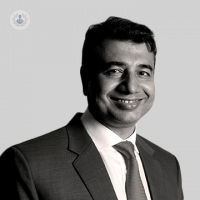The nuts and bolts of spinal fusions
Autore:When one looks at all the different spinal surgery options that are out there, it can seem very confusing and daunting. That’s why we asked neurosurgeon Mr Irfan Malik to explain spinal fusion surgery, what options are available to patients and how long we should expect recovery to take. Let’s take a look.

What is spinal fusion?
Firstly, spinal fusion is an operation to fuse or join together two segments of the spine.
The spine is made up of:
- Bones to provide support
- Discs that act as shock absorbers between bones
- Ligaments to hold everything together
- Muscles to allow movement
Sometimes, discs degenerate as we age or after some trauma, and cause problems in the spine. When discs become damaged, it can result in back pain and pain down the legs like sciatica. Treatment is needed when the pain persists and prevents the lower limbs from being able to function correctly.
How can pain caused by damaged discs be treated?
A simple decompression can free up trapped or compressed nerves, caused by disc damage. A trapped nerve can cause leg pain, weakness and numbness. Decompression involves removing the disc at the back of the spine to free the trapped nerves, releasing the pain.
However, if the pain continues or gets worse, more bones may need to be removed, but this can cause the spine to lose stability. The surgeon then has to insert something into the spine to hold it in place as the bones grow and the spine becomes stable again. This is when spinal fusion surgery is needed.
So, what are the different types of spinal fusion surgery?
PLIF (Posterior lumbar interbody fusion)
The disc is removed from the posterior (back) of the lumbar (lower spine). The disc is replaced with a cage or spacer to allow space for the nerves to try and work properly again. The fusion part of the operation involves inserting a screw in the level above and below the affected disc, holding them together to keep everything stable until the bones have grown and formed one spinal segment. This is the fusion part of the operation.
Bone graft can be inserted along the edges of the spine bones to encourage the bones to grow faster.
TLIF (Transforaminal lumbar interbody fusion)
The disc is removed by being accessed from one side of the lumbar or lower back, usually 2 to 3 centimetres away from the centre. The operation is carried out through small incisions, like those made with keyhole surgery.
ALIF (Anterior lumbar interbody fusion)
The disc is accessed via the anterior or front of the stomach. A larger spacer is inserted into the disc space. This surgery is often followed by minimally invasive posterior fixation, inserting screws in the back to hold everything together in the spine until the bones fuse.
XLIF (Lateral lumbar interbody fusion)
The patient is placed on their side and the disc is removed directly from the side. This surgery is also often accompanied by screws in the back to hold everything together until the bones fuse.
What to expect with recovery
Recovery varies, depending on the individual and the type of fusion surgery. Patients generally go home a few days after surgery and can get back to normal activities after about 6 weeks.


